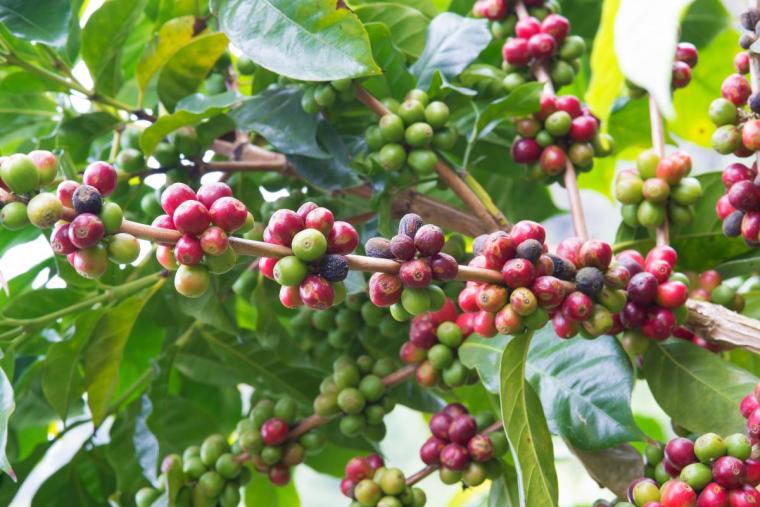A Better Morning Brew: Researchers Shed Light on the Asynchronous Flowering of Coffee Plants
By Caroline Reisiger
3 April 2023

Coffee fruits ripening on a branch.
When we drink our morning coffee, we don’t often think about how it managed to get into our mugs. We should, though, because the flowers that produce the coffee beans have an interesting story to tell.
Typically, plants flower in response to a variety of environmental conditions, including day length and temperature. But coffee grows in the tropics, where conditions tend to not vary as much. As a result, coffee has the ability to flower asynchronously (at different times), although the mechanism that allows it to do so has only recently been investigated.
Coffee flowering typically occurs twice a year and each flowering period can span up to three months. Although individual flowers don’t last long, each tree can have many flowers at different stages of development at the same time, and some trees at a coffee plantation might flower at the beginning of the three months, while some might not begin flowering until several weeks later.
It also takes two years from when the plant begins flowering to when the fruit is ready for harvest —a long time to wait for a freshly brewed cup!
These features of the coffee plant make harvesting quite challenging. Beans ripen at different times, based on when each individual flower bloomed. Due to this asynchrony, coffee beans often must be handpicked, which is quite tedious.
Solving this problem first requires an understanding of how and why coffee flowers over such a large window. Plant hormones known as florigens may hold the answer.
Florigens are made in plant leaves and promote flowering across many plant species. In perennial crops like coffee, florigens can induce flowering at some places on a branch, while vegetative growth continues in other parts of the same branch.
Dr. Joe Colasanti, an associate professor in the Department of Molecular and Cellular Biology, studies florigens in crops.
“As of now, florigens in high-value perennial crops like coffee are mostly unexplored,” he says. Bridging this knowledge gap, however, could provide coffee growers much needed insight into the flowering cycles of their trees.
Colasanti worked with former undergraduate researcher Catherine Fust as well as a group of researchers from Lavras University in Brazil, including lead visiting scientist Carlos Henrique Cardon, to examine florigen in coffee plants and shed some light on its flowering mechanism.
By comparing the gene sequences of coffee with a model plant species, Arabidopsis, the group was able to identify a probable florigen in coffee, which they named CaFT1. To show this hormone’s role in floral induction, they inserted and then overexpressed the CaFT1 gene in Arabidopsis plants and observed early flowering behaviour, indicating this hormone does trigger flowering.
They also observed an association between the CaFT1 protein and a known floral regulator in Arabidopsis, called FD, further confirming that CaFT1 indeed contributes to the flowering process in coffee plants.
The group then tested coffee tree leaves for over a year to determine when the CaFT1 gene was being expressed. Interestingly, they found this florigen was expressed almost continuously, but in varying amounts from February to October. This gives each plant multiple options for when to flower —and may explain the asynchronous flowering observed in plantations.
This discovery has significant implications for the coffee industry.
“By better understanding this large floral induction window, we are providing a basis of knowledge that could be used for breeding coffee plants which bloom in synchrony,” explains Colasanti. “This would make harvesting much more straightforward and efficient.”
So, the next time you drink your morning brew, will you think about coffee plants and these scientists working to grow its future?
Colasanti, an avid coffee drinker and amateur roaster, praises Fust, Cardon and the other authors of the study for their dedication while working with such a challenging perennial study species.
“Everyone working together, both here and in Brazil, saw the project through despite multiple rounds of data collection. This work would not have been possible without the persistence of each member of the team.”
This study was funded by Conselho Nacional de Desenvolvimento Científico e Tecnológico, INCT-Café, and a Natural Sciences and Engineering Research Council Discovery grant.
Read the full study in the journal Plant Science.
Read about other CBS Research Highlights.